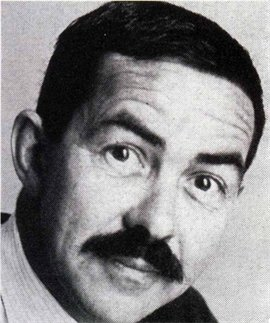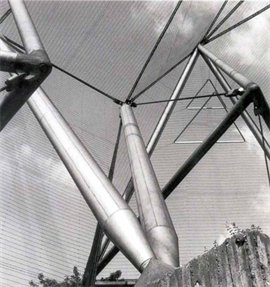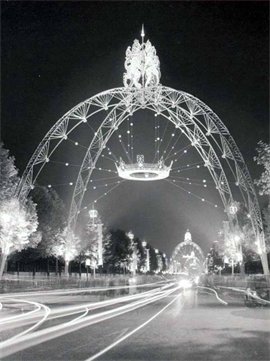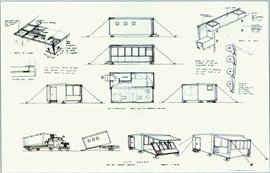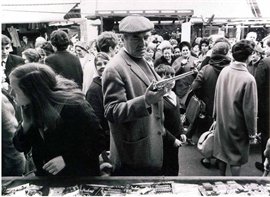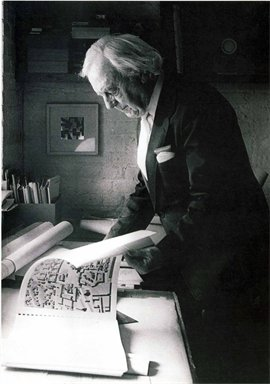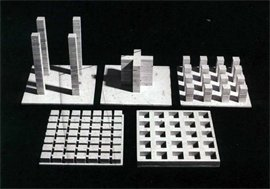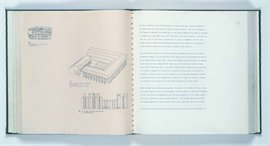1912-2012: The Department celebrated its Centenary in 2012 and held a series of events.

The Cambridge School of Architecture: a Brief History
by Andrew Saint
Schools of architecture started in Britain later than in continental Europe and the USA. Before 1900 budding architects learnt their trade as articled pupils or assistants in offices, supplementing their knowledge in the Victorian cities with evening or day-release classes. The Edwardian years saw a stampede to create a proper system of architectural schools. Cambridge was one of them. It began in a small way and with a less vocational bent than the bigger urban schools.
The initiative to teach architecture in the University started with Charles Waldstein, later Sir Charles Walston (1856- 1927), classical archaeologist and twice Slade Professor of Art. Waldstein was a polymath who had been educated at American and German universities. There architecture and history of art were respected and systematically taught, unlike the older British universities. At Cambridge, art and architecture had been touched on only in classics teaching and in the intermittent lectures of the Slade professorship, established in 1869.
Waldstein's original idea, first canvassed in 1904, was to teach architecture not for professional purposes but as part of a Cambridge liberal education.Nevertheless because of the strong demand for training, the scheme he put forward in 1906-8 included a vocational element. Among its supporters were William Ridgeway (1858-1926), professor of archaeology, and D H S Cranage (1866-1957), later Dean of Norwich, in charge of Cambridge's extra-mural teaching and a lecturer on mediaeval churches. The proposal for a diploma in architecture was coolly received by the University, which disliked the professional training element - always suspect in Oxbridge degrees. A 'preliminary examination' was approved instead. But no funds were voted and though the exam may have been held, no teaching took place before 1911 when Waldstein put in £1,000 of his own money to get things going. By arrangement, he then resigned the Slade Professorship. It was inherited on a lifetime basis by Edward Prior (1852-1932). Prior was a Cambridge graduate and a notable Arts and Crafts architect. He already had a high local reputation, on the strength of what is now the Zoology Building (1899-1902). Effectively he was first head of the school, though never so in name.
Prior delivered his inaugural lecture, 'Art Study at Cambridge', in May 1912. The text picks a path midway between the teaching of architecture as a practical building craft and teaching architectural history, ideas and appreciation to amateurs and scholars. That ambiguity was to be perpetuated; the Department in its early years is best interpreted as a combined school of architecture and art history. Teaching began that October under the management of a Board of Architectural Studies. There were three students in the first year, one of whom, Kenneth Cross (1890-1968) was to become an architect of note and PRIBA. Six joined the following year, including Graham Dawbarn (1894-1976) and Henry C ('Hugh') Hughes (1893-1976). The first instructor in design and drawing was Matthew Dawson (1875-1943), who commuted up from London. Practical and humanistic strands were blended in the curriculum. Lectures from Prior, Waldstein, Cranage and others were a strong point; the technical side, though present, was weaker. 'Architectural Studies' at this stage was not a stand-alone subject; its two parts, which took a year each, added up to half a Cambridge degree (without honours). The first premises consisted of a single room close to the Squire Law Library.
There was a hiatus during the First World War, when a modicum of research was carried on. Teaching resumed in 1919, the 'University School of Architecture' now establishing itself on the first floor of 75 Trumpington Street. T H ('Harry') Lyon (1870-1953) became the principal teacher of design, with Hughes and, briefly, Dawbarn as his assistants. Numbers rose sufficiently for Theodore Fyfe (1875-1945) to be appointed in 1922 as first full-time director of the school, and women began gradually to be admitted. The school moved to 1 Scroope Terrace in 1924. Prior's role dwindled from this time. Under Fyfe, a Scot who had worked on the first excavations at Knossos, the school's tone became more pronouncedly classical and professional. But it was always small and poorly funded, with low salaries for the staff. Indefatigably in the background of discussions about the design teaching throughout the 1920s was Beresford Pite (1861-1934),an architect as distinguished as Prior, who came up from London to lecture, The fine-arts side of the teaching remained strong, lectures being given by local academics including the psychologist of aesthetics Ernest Bullough. So the Department still combined the subjects of architecture and art history. This marked Cambridge out from other British schools of architecture. It was confirmed by the change in management from a Board of Architectural Studies to a Faculty Board of Fine Arts in 1926.
Modernism was marginal in the Cambridge school before the Second World War. The Art Deco-tinged alterations to Finella (1928), for the don Mansfield Forbes, the first such work in Cambridge, were by the Australian Raymond MeGrath (1903-77), who enrolled as one of the department's first doctoral students but failed to finish his PhD. George Checkley, a New Zealander appointed 'demonstrator' in 1925, built two modern houses in 1932 but then left. The series of fine local houses by Hugh Hughes are better tokens of the gradual evolution in fashion, along with his more firmly modernistic Mond Laboratory (1932) and Fen Court, Peterhouse (1939-40). These were designed with his younger partner Peter Bicknell (1908-95), who like Hughes became one of the school's stalwart local practitioner-teachers. Another such was Harold Tomlinson (1899-1951), who with William Parker Dyson rebuilt Cambridge's student auditorium, the ADC Theatre, after a fire in 1934.
James Macgregor (1889-1953), a Scot who had been in Lutyens' office before specialising in architectural education, came from the Edinburgh College of Art to succeed Fyfe as director of the school in 1937. On the eve of the war the course was still as yet only for the three undergraduate years, about sixty students in all. A diploma exam could be taken two years after graduation, but as yet there was no actual diploma course. Research, commented a survey of schools, "tends to be looked down on," though "the Cambridge School, perhaps more than any other, has the potential resources required for that architectural research, in the broadest sense, which is so necessary if modern architecture is to develop". Bright students of the period included Edric Neel, Hugh Casson and the architectural fantasist Tom Greeves.
During the Second World War the larger Bartlett School was evacuated from London to Cambridge and some joint teaching took place. Despite ambitious plans for the future, Macgregor and his staff found it hard to adapt to post-war conditions and the school declined. But outstanding students such as Edward Cullinan and Cedric Price still passed through. In 1946 a fine teacher and architect arrived in the shape of David Roberts (1911-82), who drew many good students into his Cambridge practice, as Hugh Hughes had done before him. Bicknell and Roberts were to be the backbone of the post-war generation of teachers who took it for granted that lecturers would build as well as teach. They regarded their offices as natural extensions to the classroom.
After Macgregor's death, Parker Dyson acted as caretaker head of the school. A decisive change came with the arrival of Leslie Martin (1908-2000) as head of school and it's first professor in 1956. The appointment was a coup. Among the most prestigious modernists in the UK, Martin had confirmed his pre-war reputation as an avant-garde architect with the popular success of the Royal Festival Hall. His intellectual air suited Cambridge; he possessed a doctorate (then rare in British Architecture), he believed in reconciling science with art, and before the war he had headed the Hull School of Architecture. Martin combined teaching and research with an atelier-style practice run from his home in Great Shelford. He also had a nose for politics and exercised extraordinary patronage over major architectural jobs throughout the country, distributed on his advice among proteges and the many young architects whom he encouraged. though often remote from the daily life of the school, Martin excelled as a memorable and perceptive studio critic. In 1958 he was one of the instigators of the Oxford Conference which led to the radical reform of British Architectural education.
The school now reorganised the undergraduate years into a full Cambridge 'tripos' (i.e. honours degree), the Diploma following on in 1960. the establishment of the two-year Diploma altered the school's centre of gravity, stimulating greater sophistication in the studio. In 1960 too history of art began to be taught as part of a seperate tripos course. Just then history seemed less relevant to the creation of architecture. though it was still intensively taught to the architectural students, the methods of doing so had begun to diverge in tenor and scope from what art historians had inculcated. The divorce of the elements combined in the setting-up of the school began to be felt. Though the Scroope Terrace premises and library were still shared.
To house the increased activity an extension was added behind 1 Scroope Terrace in 1958-9, designed by Colin St John Wilson and Alex Hardy. Upstairs was for teaching, while below were a staff common room and four rooms for researchers. The brick-and-concrete idiom of the extension prefigured the 'Cambridge modernism' identified with Martin and his disciples, while flaunting it's own Corbusian pedigree. In cooler, Scandinavian guise it enjoyed a strong and long following in British architecture, running through from Martin's own Harvey Court for Caius College (1960-2), designed with Wilson and Patrick Hodgson, to such late examples as the Burrell Collection, Glasgow, by Barry Gasson, John Meunier and Brit Anderson (designed 1971, built later) and Wilson's British Library (1978-97). Perhaps the most polished specimen of this gentlemanly modernism in Cambridge is the eight-storey William Stone building at Peterhouse by Martin and Wilson (1963-4).
Teachers and researchers of different hues were drawn to the school in the Martin era. Colin Rowe was an assistant lecturer for some years from 1958; Peter Eisenman came to write a doctorate in 1960. The school pledged its commitment to a continuous relationship between research, teaching and practice by inaugurating the Centre for Land Use and Built Form Studies in 1967, under the direction of Lionel March but with early personal involvment from Leslie Martin. The Centre's original goal was to apply geometrical principles to ground coverage and building form, with better housing layouts foremost in mind. This work influenced the thinking of such architects as Richard MacCormac. Research topics proliferated, as computer studies started to impinge on architecture. In 1974 following Martin's retirement the enlarged research team, by then located away from Scroope Terrace in Brooklands Avenue, was renamed the Martin Centre. Meanwhile in Scroope Terrace a full Department of History of Art was created to stand alongside the Department of Architecture in 1970, the two departments combining to form a Faculty of Architecture and History of Art. Under the guidance of Robin Middleton a joint Faculty Library now developed into the best such library in the UK.
Martin's successor in 1973, W G ('Bill') Howell (1922-74), was already well known as the prime mover in the firm of Howell, Killick, Partridge and Amis and the author of such powerful Cambridge buildings as the University Centre (1964-7) and the Senior Common Room at Downing College (1966). After little more than a year Howell was killed in a road accident, to be succeeded in 1975, after an inter-regnum, by Colin St John Wilson, whose tenure continued until 1989. From the late 1960s there was growing variety and freedom in the studio teaching, occasionally culminating in unrest. It was still taken for granted that most of the lectureships would be taken by practitioner-teachers, exemplified over the years by such figures as Bruce Martin, David Thurlow, Bob Allies, Nicholas Hare, John Sergeant, Eric Parry and Nicholas Ray. But a growing separation between architectural schools and practice, with the former tending to cast themselves as self-sufficient powerhouses, was naturally felt in Cambridge.
By the 1980s the school's internal culture had taken divergent paths. On the one hand there was the science-style research culture of the Martin Centre, settled by now in Chaucer Road, undertaking contract research and appreciated within the University at large. Here, while studies of spatial form (under Philip Steadman and others), urban modelling (under Marcial Echenique) and acoustics (under Michael Barron) successfully continued, environmental design in particular was burgeoning as a speciality, led by Dean Hawkes. On the other hand as reaction deepened against the intellectual vacuity of much modern architecture, a more cultural reading of the subject developed at Scroope Terrace, reflecting the anti-instrumental concerns of Joseph Rykwert (briefly a reader), Dalibor Vesely and Peter Carl. While both wings generated masters' courses of the kind now common in schools of architecture, and both were represented in the studio teaching, the Diploma studios became favoured as a vehicle for speculation.
By the time Peter Carolin succeeded Wilson in 1989 pressures were becoming felt which tended ultimately towards the lessening of ideological differences. These were prompted by the weapon of the Research Assessment Exercise, which with increasing rigour allotted money to universities and departments on the basis of their success in research as judged by their academic peers - a process conducted with alleged objectivity. British schools of architecture, with their intensive teaching habits and subjective modes of assessing design, were not best placed to meet these criteria. But the Cambridge school did well enough in all the assessments up to 2001. In parallel with increased research income and activity, teaching was at a zenith in diversity and intensity during the 1990s, and staffing grew to reflect that priority. The undergraduate and Diploma courses during these years hardly rose in numbers, despite the extraordinarily high level of applicants - which has been maintained. But the number of graduate students and the opportunities available to them increased. Many Cambridge-trained alumni, whether in architecture proper or in one of the higher degrees, now went on to teaching and research careers elsewhere. One such was Catherine Cooke, who taught at the Open University and became the world's leading expert on Russian constructivism in architecture and design. On the research side, an important extra component had been added to the Martin Centre in the shape of the CAD lab under Paul Richens, while Robin Spence's work on natural disaster mitigation continued to flourish.
By 2000, when Peter Carolin retired, to be succeeded (after an interim period under Nicholas Bullock) first by Alan Short and then by Marcial Echenique, there were three masters' courses, including one connected with the innovative Cambridge University Moving Image Studio (CUMIS) under Francois Penz. An innovative interdisciplinary course (IDBE), run jointly with Engineering, had also been established for professionals already active in the construction industry. This, under the initial leadership of Giles Oliver, helped heal some of the wounds inflicted by the growing gap between teaching and practice.
In the longer term, the effect ofthe RAE has been to elevate the research work at the expense ofteaching time. Structures and appointments within the school in recent years have reflected this; personal professorships and readerships have expanded, and the successful bid for a research grant has come to be seen, on the arts as well as the science side, as the prime contribution a staff member can make. The biggest loss has been the withering of the practitioner-teacher tradition among permanent appointments. Nevertheless it must be added in conclusion that at no point over the past fifty years has there not been a disproportionate number of Cambridge graduates in the leading London offices. While the research tradition has been favoured, and the mix of culture and training with which the school begun is fervently maintained, most students who enter the school of architecture still do so to learn how to become practising architects, and many continue to be outstandingly successful in that field.
Note: This essay was originally written for the Architecture Department's Compendium Exhibition catalogue in 2006.





